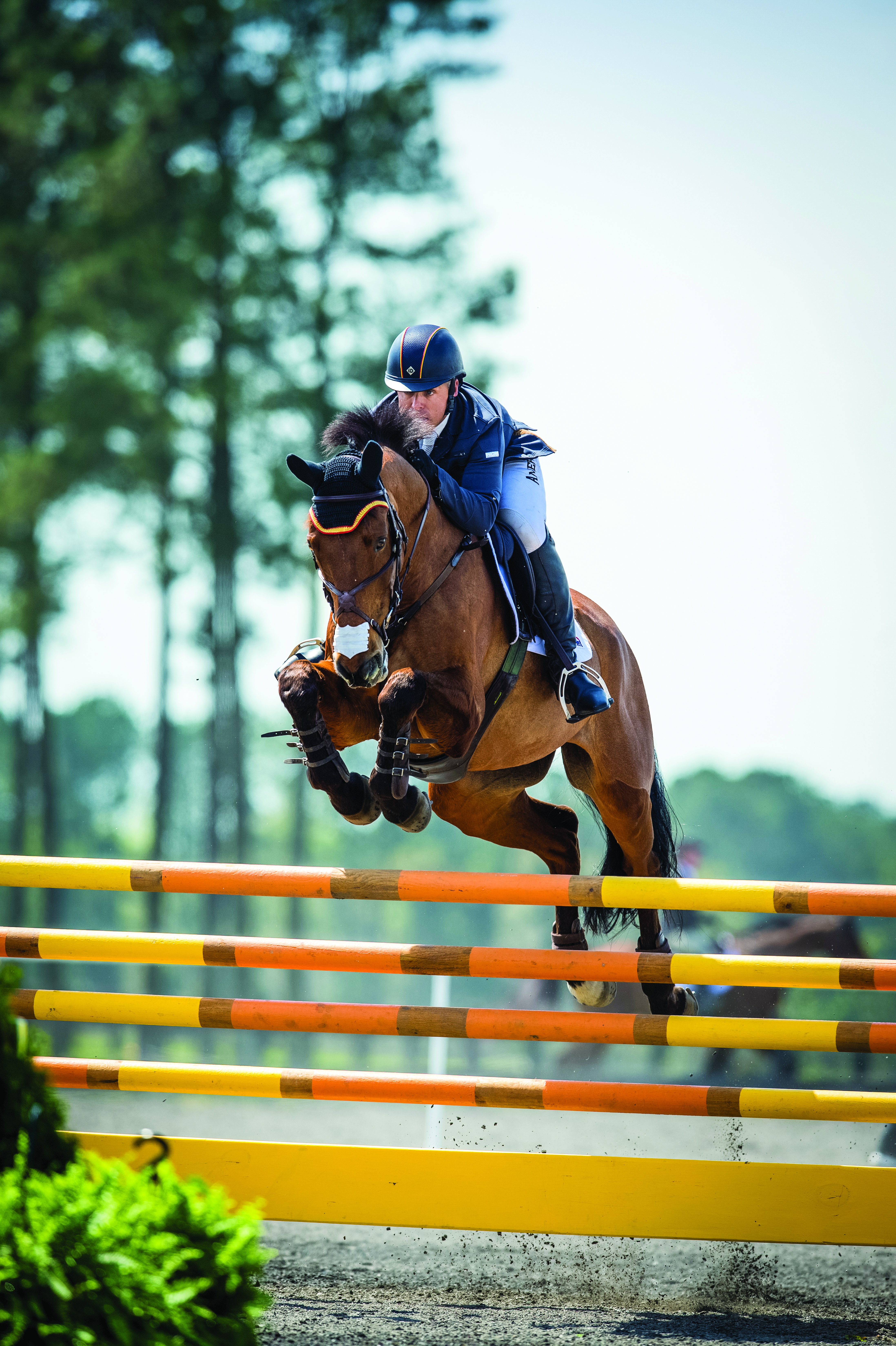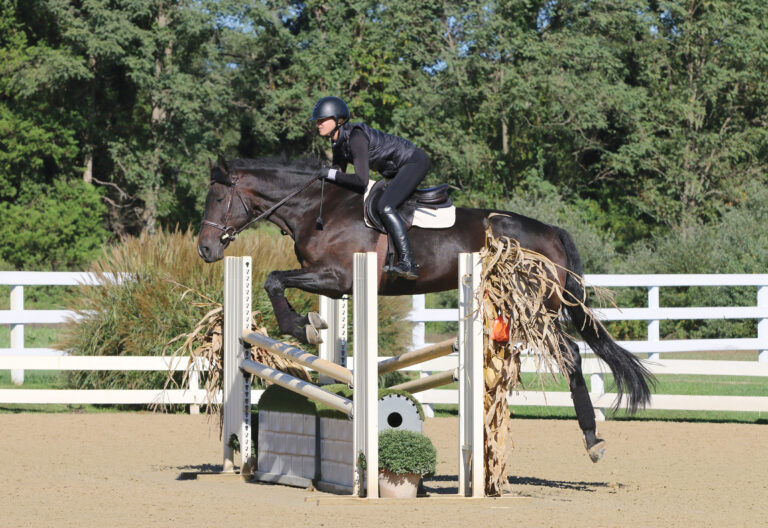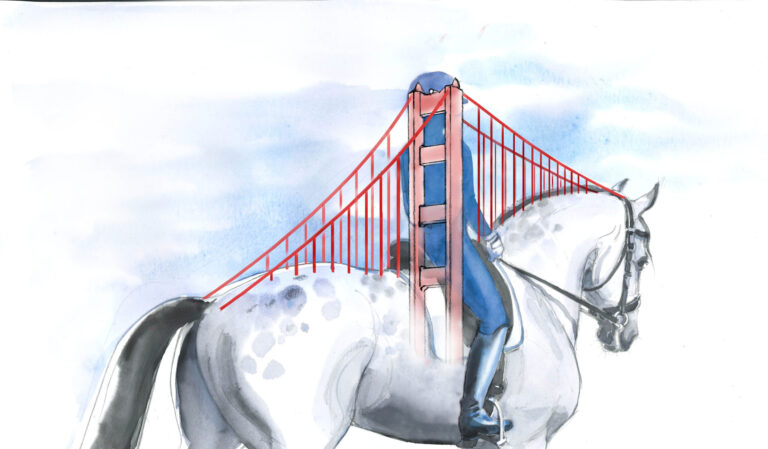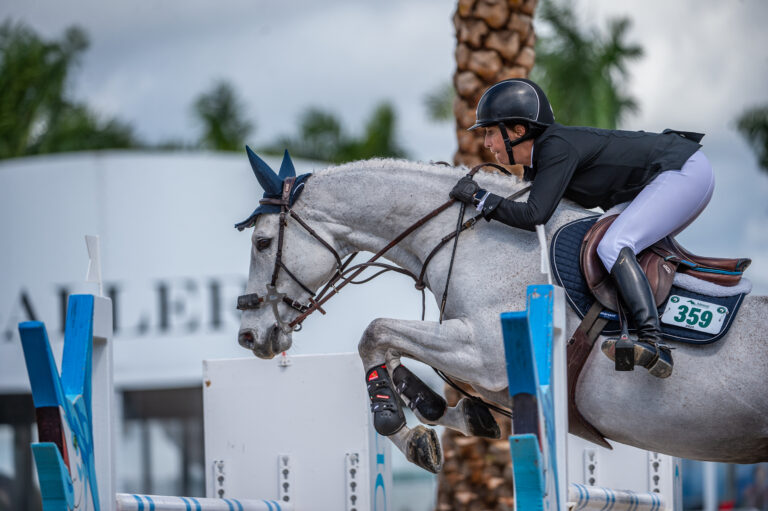A top placing at a three-day or one-day event can likely hinge on a clean show-jumping round, which is why riders need to prepare for a successful performance in the ring with a smart warm-up plan.
International three-day eventer and top-ranked U.S. rider Buck Davidson, aided by the U.S. Eventing Team’s Show Jumping Coach Silvio Maz zoni, shared his thoughts on how to ride a well-prepared show-jumping warm-up and his routine for three of his top mounts. “Training horses is about consistency,” Buck says. “If you want to teach your horse to jump a barrel without a bridle and saddle, you can do that. As long as you train your horse the same way, he will understand what’s expected.”
Begin at Home
Buck says the foundation for your show-day warm-up starts with developing a routine back at the home base and knowing your horse. “You have to ride your horse on show day the way the horse knows you will ride him. You should be consistent. Don’t go to the event and try to be somebody else. Do what you normally do, do it well and you’ll be fine.”

Achieving the ride you want on show day means trying different things at home so that you know what works for your horse and what doesn’t. Experiment with flat exercises that address your horse’s weaknesses and help encourage balance, adjustability and straightness. Introduce fences at different stages of your warm-up so you know about how long your horse needs on the flat before he’s ready to jump his best. Some horses are better jumping after a brief flatwork session, while others need more time to be attentive, supple and relaxed.
Buck suggests experimenting with the length of your warm-up. Does your horse need 10–15 minutes before jumping a course in good form or does he need 20 –30 minutes of exercises before coursework? Does your horse tire easily? Is he greatly influenced by weather? All of these variables play a role in your day-to-day training and your show-day warm-up.
Develop Consistent Training
When Buck is working his horses at home, he likes to do grid work such as bounces followed by course work then go back to grid work. Grid work helps get the horse in better form and makes him quick on his feet. Technique and strong footwork are needed to jump a balanced, rail-free course. Starting and ending with grid work reinforces the lessons you want the horse to remember come show day. “Through trial and error, you realize what works and what doesn’t and what makes your horse jump the best,” he says. “As you get more educated with your rides, the variables that come up in eventing aren’t that big of a deal.”

Buck says riders and horses can be thrown off schedule on show day by things like delays. If suddenly there are 10 rides ahead of you instead of five, you might want to change your warm-up strategy. Especially if you’re on a young or inexperienced horse, more time on his back can cause him to tire or get more nervous. Buck suggests that if you have the luxury of a ground person, ask her to find out if show jumping is running on time and whether there have been a lot of holdups on course, like refusals, which cause delays.
Build Confidence Early In the Season
For Buck, setting a show-jumping warm-up plan depends on the competition, the horse’s experience and where he is in the standings. He says clean rounds are ideal at the bigger competitions, especially later in the season. However, early in the season, he’s not as concerned about getting perfect rounds. “Rideability and relaxation of the horse at the beginning of the season are huge. Sometimes you have to sacrifice a rail or two if it means making sure the horse is jumping with good technique and with confidence.”
Buck’s advice to riders is to be as smooth and as accurate as possible versus getting too competitive early in the season. He emphasizes that especially with young horses, you should take your time to develop confidence in the beginning of their training. That way, you can work out any issues when the jumps are low versus when the jumps are high and the consequences are greater. Too often, he says, riders rush young or green horses. “Chances are, you’re going to have the horse for a while and you want him to last. Take it slow at the beginning of the season and just have fun.”
Ride with a Long-Term Strategy in Mind
Buck isn’t big on changing his routine with more creative tactics on show day. For instance, while some people put a towel on the rail of a warm-up fence to prepare for a scary jump on course, he’d rather stick to what he does at home. He says these things might work for the short term for some horses, but he recommends keeping the bigger picture in mind—that is, practicing scary jumps at home and building confidence every day so there are no issues come show day. “If you start to throw in different things at the show, you will likely confuse your horse, make him nervous and put his attention on you and not the fence. That’s a sure recipe for knocking down rails.”
Buck emphasizes riding according to the horse, not the course. “If the horse is listening to me, the course will take care of itself. If you warm up according to the course and do tricks to get the horse ready for that one moment, your strategy might work once or twice, but over the long haul, it’s not a successful way to train.”
Plus, altering the warm-up fences at some competitions may not be allowed. To avoid unwanted penalties, Buck advises that riders check the rulebook before making any changes to the warm-up fences.
Focus on Technique and Form
Depending on which horse Buck is riding, he may adjust the ground line or add a placing pole during warm-up if allowed. He says Silvio has been instrumental in helping him adjust his strategies for different horses. “I’m very big on working to get a better technique and teaching a horse to show jump clean, in the right form with the least amount of interference or help from the rider,” says Silvio. “You have to teach the horses and riders to jump in balance and to use themselves on their own. Riders must show the horse the easiest route over the jump to go clean, especially if they are tired, having jumped cross country that day or the day before.”

In the past, if Buck was riding a horse who dangled his front legs over the fence, he would try to get him deep into the fence or take off closer to the base of the fence. If the horse takes off close to the base of the jump, in theory, he will make more of an effort to pick up his feet.
Rather than ride deep, Silvio advised Buck to give the horse more room by moving the ground line farther out from the fence. Pushing the ground line slightly farther away encourages the horse to make a rounder shape over the fence. “You have to give the horse more room and build his confidence,” says Silvio. “Some horses are shy at shows, which is why it’s important to build their confidence and work on their form in warm-up.”
Silvio has also encouraged Buck to use placing poles 9 feet in front of the fence and 10 to 12 feet behind the fence on show day to encourage better form and balance. “Especially if a horse has already completed cross country and has jumped fast, flat and sometimes out of stride, you need to remind the horse that he needs more of a round shape to clear a show- jumping fence successfully,” advises Silvio.
On show day, Buck uses pole work as Silvio suggested with experienced horses who have done these exercises many times at home. For less-experienced horses who are otherwise distracted with crowds, announcers and signs, he recommends practicing pole work at home so you don’t scare them or confuse them at the show.
For a closer look at Buck’s show-day strategies, here’s how he warms up three of his top horses.
Petite Flower
“Flower” is a 2002 Thoroughbred mare who placed ninth at last year’s Rolex Kentucky Three-Day Event in Lexington. According to Buck, Flower is a ridiculously good jumper and very careful. For show day, he warms up with 10–15 minutes of flat work, then jumps her over five to six fences before entering the ring.

With Flower, Buck says his main challenge is to keep her straight. She tends to fall on the left shoulder and swing her hips to the left. If not corrected, her canter and bascule—the natural arc she makes with her body over the fence—are compromised, which could lead to rails. To make the corrections, on the flat, before he jumps any fences, he asks for haunches-in by putting weight on his inside seat bone with his inside leg at the girth and outside leg slightly behind the girth. He then asks Flower to cross her haunches underneath herself. His outside rein remains steady, helping to keep Flower’s neck straight, while the inside rein asks for a slight flexion. By maintaining straightness, Flower is better able to rock back on her hind end and push off over the fence.

In addition to her straightness, Buck also works on encouraging Flower to lengthen her canter stride to cover more ground because she has a naturally bouncy (up and down) canter. He does this by asking for transitions within the gait, going forward and slowing down within the canter, then maintaining the desired canter around the warm-up ring.
Once she’s straight and through the back, meaning she’s supple in her poll and moving freely from behind, Buck begins to jump with an uneven oxer that has a back rail higher than the front rail and is set at 3-foot-6. He comes to the fence with a very forward, open canter, not worrying so much about the distance to the fence. His goal is to keep her relaxed yet forward so she can use her back in the air.
After jumping the oxer twice, he raises it three holes all around and jumps the fence from each direction. Once she jumps the higher oxer successfully, he raises it to maximum height at 4-foot-3. After she clears the fence, he jumps a vertical at 3-foot-9 then at 4-foot-3. He finishes up with another uneven oxer at 4 feet or 3-foot-11 just to make sure she has a good shape before entering the show ring. He typically gives her a walk break before and after jumping the vertical.
Ballynoe Castle RM
Buck’s longtime partner, Ballynoe Castle RM, or “Reggie,” is a 2000 Belgian Warmblood/Irish Thoroughbred. The pair has had multiple showings at the Rolex Kentucky Three-Day Event CCI****, competed at the 2010 World Equestrian Games and traveled to Hong Kong and London as alternates for the U.S. Eventing Olympic squads in 2008 and 2012, respectively.

Buck says Reggie doesn’t require a lot of flatwork before his round, and he typically doesn’t jump more than a handful of fences before he goes into the ring. As he’s warming up, he does transitions within the canter and might ask for a walk pirouette or rein back to make sure Reggie is listening and engaged. For the walk pirouette, Buck collects the walk, simultaneously flexing Reggie slightly to the inside. Then he activates the horse’s inside hind leg using his own inside leg at the girth with his outside leg slightly behind the girth to keep the haunches from falling out. The combination of seat, legs and rein aids helps control Reggie as he puts weight on his hind end and turns his front end around his haunches.

As he starts to jump, Buck takes Reggie over an uneven oxer one to two times at 3-foot-6, then raises the fence three to four holes. He keeps the oxer wide so that Reggie stretches over the fence rather than jumps high and comes down on the back rail. After the oxer, Buck jumps over a vertical, sometimes with placing poles 9 feet in front and 12 feet in back to help Reggie be more round in the air and more balanced. If Buck is pleased with the way Reggie jumps the vertical, he leaves it at that. If not, he’ll jump another uneven oxer before heading into the ring.
“Reggie knows how to jump better than I do. As long as I know the course, I know I’ll be OK.”
Park Trader
Park Trader, or “Kobe,” is a 2002 Irish Thoroughbred gelding who completed last year’s Rolex CCI****. Kobe is an unorthodox horse according to Buck. He’s very careful, very sensitive and doesn’t like a lot of leg pressure. If Buck is too strong with his leg aids, Kobe backs off and often loses momentum, which is why he doesn’t ride him with spurs.

With Silvio’s help, Buck has been able to overcome Kobe’s issue with leg pressure and improve his performance in the show ring. “You can’t use hands without leg, and since Kobe doesn’t like leg, we’ve worked on opening Buck’s hands,” says Silvio. “This means less direct pressure on the bit. [Horses] will go where you open the door, so we’ve opened [Buck’s] hands to give [Kobe] the space and desire to go forward without too much leg.”

When opening his hands in warm-up, Buck will ask for a hand-gallop to encourage forward momentum. If he feels Kobe stalling over the fences (and consequently dropping rails), rather than apply his leg at the girth, Buck lets his leg slip behind the girth, causing Kobe to kick up a bit with his hind end over the fence and clear the back rail. “It doesn’t make for pretty pictures, but it works,” says Buck.
Buck jumps a few more fences with Kobe than with some of his other horses to ensure he is jumping forward (but not rushed) and in a nice shape. He starts with a square oxer, where the rails are even. A square oxer is more difficult because sometimes the horse doesn’t see the back rail until the last minute. For Kobe, this kind of oxer gets his attention and makes him pick up his feet when he’s feeling a little lazy.
Buck jumps a square oxer four or five times at 3-foot-6 with a ground line set farther out in front of the fence so that Kobe has a nice big jump. If Kobe’s shoulders start to bulge left or right, Buck widens his hands, which helps him hold Kobe’s shoulders in place. After jumping the square oxer, Buck will take him over a vertical or oxer at 4 feet or he might leave him with a 3-foot-6 fence if he’s jumping well. “If I have him happy at 3-foot-6 and he’s rideable, listening and forward, I’m good with that. The jump height isn’t as important as his rideability.”
While some riders are OK ending a warm-up with the horse hitting a rail, Buck might jump one more to ensure a smooth ride. “Some horses pick up their feet after hitting a rail. With Kobe, the more rails he hits, the madder he gets. He’s not a horse you want to trick. A happier Kobe is a better Kobe.”
Rideability is Key at Lower Levels
With a horse going Novice or Training division, Buck’s priority is rideability first, clean round second. To achieve the desired rideability, Buck uses transitions, circles and figure eights to get a steady, relaxed, balanced and rhythmical horse.
Buck usually jumps more fences—seven to 10—with young or green horses than with his more-experienced mounts so that when he enters the show ring, it feels as if he’s already jumped half of the course. He suggests starting with something small and easy like a crossrail. Then work your way up to a small vertical and a small oxer. “Don’t worry so much about the height of the fence. You want the horse to feel confident. You want him to trust you and listen to you. Come in a little forward to one fence and a little slower to the next.”
He emphasizes staying out of the horse’s way and letting him make mistakes so that he figures out how to fix them in the future. He notes that green horses sometimes struggle because their canter isn’t strong yet, but says that will come in time. “Kicking and pulling at the lower levels will bring you a horse that is locked in his back and nervous. Give them room to jump. Be patient. Make it fun for the horse and yourself!”
If you have a young or green horse who is balanced but still knocking down rails, go back to the flatwork at home and work on developing a stronger hind end. He suggests doing a lot of hills and transitions and using gymnastics in your flatwork or jump work twice a week.
Depending on whether you are competing at a one- or two-day event, Buck says to always monitor your horse’s well-being and energy level. “I’d rather jump one too few fences than one too many. If you hurt them, you’re going nowhere. Trust your instincts and see it through over the long haul.”











